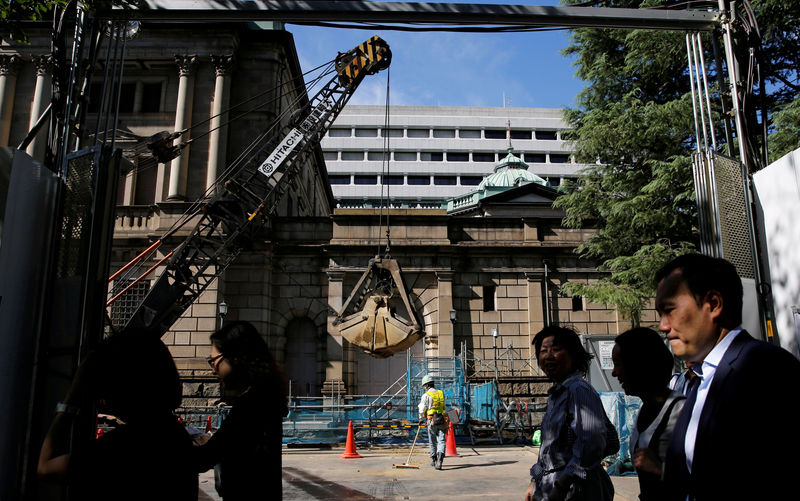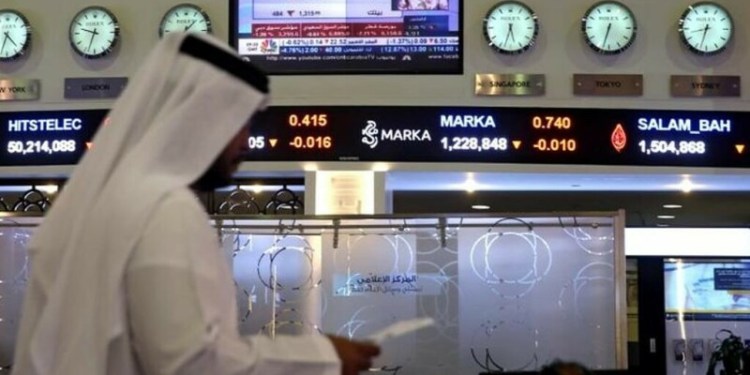 © Reuters. FILE PHOTO: People walk past the Bank of Japan building under construction in Tokyo
© Reuters. FILE PHOTO: People walk past the Bank of Japan building under construction in TokyoBy Leika Kihara
TOKYO (Reuters) – The Bank of Japan is dropping subtle, yet intentional, hints that it could edge away from crisis-mode stimulus earlier than expected, through a future hike in its yield target, according to people familiar with the central bank’s thinking.
With inflation still way below its 2 percent target, the BOJ sees no immediate need to withdraw stimulus, and regards weak price growth as its most pressing policy challenge.
But bank officials are now more vocal on the rising cost of prolonged easing, such as the hit to bank margins – a sign that their next move would be to roll back stimulus rather than expand it, the people said.
The most likely first step – albeit some time away – would be to allow long-term rates to rise more, reflecting improvements in the economy, they said.
“The change in tone doesn’t have immediate policy implications, but it’s probably intentional,” one of the people said.
“The BOJ wants to make its policy framework more sustainable,” said another. “Allowing longer-term rates to rise more would give banks some breathing space.”
The first sign of change came in Nagoya on Nov. 6, when BOJ Governor Haruhiko Kuroda – whose current term ends in April – said he was “mindful” of the risk prolonged easing could hurt banks’ appetite to lend.
Days later, board member Yukitoshi Funo said the BOJ must be vigilant to the cost of easing.
The most striking warning came from Kuroda last week, when he referred to a “reversal rate” – the level where rate cuts by a central bank hurt, not help, the economy by damaging banks and discouraging lending.
“Because the impact of the low interest rate environment on financial institutions’ soundness is cumulative, the BOJ will continue to pay attention to this risk,” Kuroda said in a Nov. 13 speech in Zurich.
European Central Bank (ECB) executive board member Benoit Coeure referred to the reversal rate in July last year in discussing when further rate cuts could become counter-productive. Five months later, the ECB decided to cut monthly asset purchases from 2017.
The BOJ also has a history of dropping early hints of a future policy shift. Roughly a year before adopting its yield curve control (YCC) policy, the BOJ published a research paper analyzing the feasibility of the idea.
“Reversal rate is a pretty shocking word to come out of the mouth of a BOJ governor. It’s unthinkable the BOJ would insert it in Kuroda’s speech without any policy intention,” said Takahide Kiuchi, who was a BOJ board member until July.
The BOJ may allow long-term rates to rise more by shifting its long-term rate target to five-year yields from 10-year yields around the first quarter of next year, Kiuchi said.
“The BOJ could put a positive spin on the move by saying it can more effectively reflate growth by keeping short-term borrowing costs low while allowing longer yields to rise.”
NO SURPRISES
After three years of heavy asset buying failed to fire up inflation, the BOJ last year shifted to a policy targeting interest rates to free itself from a commitment to buy bonds at a set pace and make its policy framework more sustainable.
Under that YCC policy it guides short-term rates at minus 0.1 percent and 10-year bond yields around zero percent.
The shift in communication comes as the U.S. Federal Reserve and ECB head for an exit from ultra-loose policy, and suggests the BOJ could follow suit sooner than expected.
A majority of economists polled by Reuters before Kuroda’s latest comments expect the BOJ’s next move to be a withdrawal of stimulus – but not until later next year or beyond.
If the economy keeps improving, the central bank may consider hiking the yield target as early as April, said veteran BOJ watcher Izuru Kato, chief economist at Totan Research.
“The BOJ probably wants to fine-tune YCC with a modest hike in the yield target, and justify the move as aimed at easing the strain on Japan’s banking system,” he said.
Indeed, BOJ officials have signaled they do not necessarily need to wait until inflation hits 2 percent to raise the yield target, as long as it keeps printing money aggressively.
But stubbornly low inflation and a potential change in governor could discourage the BOJ from any early policy change.
“The BOJ would struggle to justify raising the yield target unless inflation exceeds 1 percent,” said Mari Iwashita, chief market economist at SMBC Friend Securities.
Core consumer inflation stood at 0.7 percent in September from a year earlier.
While the timing of a rate hike remains uncertain, one thing is sure: the BOJ won’t spring a surprise like the time Kuroda deployed his ‘bazooka’ monetary stimulus in 2013.
“It’s important the BOJ prepares markets in advance with careful communication,” said a third person familiar with the bank’s thinking.
Source: Investing.com





























